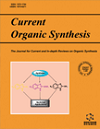- Home
- A-Z Publications
- Current Organic Synthesis
- Previous Issues
- Volume 7, Issue 4, 2010
Current Organic Synthesis - Volume 7, Issue 4, 2010
Volume 7, Issue 4, 2010
-
-
oa About the Editor
More LessJetze J. Tepe was born in Gouda, The Netherlands in 1968. He received his BS degree in 1992 from Jacksonville University, Florida and was awarded a PhD from the University of Virginia in 1998 where he worked with Prof. Timothy L. Macdonald on the design and synthesis of topoisomerase II inhibitors as potential chemotherapeutic agents. Following his PhD studies, he joined the laboratory of Prof. Robert M. Williams as a post- Read More
-
-
-
oa Editorial [Hot topic: Recent Advances in Cycloaddition Reactions in Natural Product Synthesis (Guest Editor: Jetze J. Tepe)]
More LessWith increasing demands on atom economy, reaction efficiency, stereoselectivity, streamlined total syntheses, as well as product diversity, new developments in cycloaddition reactions are excelling at an ever increasing pace. Cycloaddition reactions are an efficient means to install multiple stereocenters and rapidly construct core skeletal structures of complex products. It is therefore not surprising that cycloaddition reactio Read More
-
-
-
Synthesis of Natural Products Using Intramolecular Dipolar Cycloaddition Reactions
More LessAuthors: Adam J.M. Burrell and Iain ColdhamThis review describes ylide 1,3-dipoles in cycloaddition reactions for the synthesis (and formal synthesis) of natural products. Examples using azomethine ylides, carbonyl ylides, nitrones, nitronates, nitrile oxides and azides are provided. These lead to a diverse array of heterocyclic products. Intramolecular cycloaddition provides two new rings in one step and hence an efficient entry to complex target compounds.
-
-
-
Enantio- and Diastereoselective Rh(II)-Catalyzed 1,3-Dipolar Cycloadditions of Carbonyl Ylides and their Recent Applications in Complex Molecule Synthesis
More LessAuthors: Stefan France and Lien H. PhunThe Rh(II)-catalyzed 1,3-dipolar cycloaddition of carbonyl ylides derived from diazocarbonyl compounds is one of the most powerful methods for the synthesis of mono- and polycyclic heterocycles. Recently, there has been a growing interest in the development of enantioselective variants of this protocol and the direct application in asymmetric total synthesis. Herein, we discuss recent advances in this field in the context of th Read More
-
-
-
The Asymmetric [C+NC+CC] Coupling Reaction: Development and Application to Natural Product Synthesis
More LessAuthors: P. Garner and H.U. KaniskanDevelopment of the asymmetric [C+NC+CC] coupling reaction is described. This reaction assembles aldehyde (C), amine (NC), and alkene (CC) components in a predictable and controlled fashion to give highly functionalized pyrrolidines. The utility of the asymmetric [C+NC+CC] coupling reaction is demonstrated by its application to an efficient formal total synthesis of cyanocycline A.
-
-
-
Aza-[3 + 3] Annulations: A New Unified Strategy in Alkaloid Synthesis
More LessAuthors: Grant S. Buchanan, John B. Feltenberger and Richard P. HsungAn aza-[3 + 3] annulation or formal cycloaddition strategy for constructing complex heterocycles, chiefly alkaloids, is reviewed here. This annulation involves a Knoevenagel-type condensation of α,β-unsaturated iminium salts with vinylogous amides or urethanes followed by a 6π-electron electrocyclic ring-closure. Both the inter- and intramolecular aza-annulation pathways illustrated here constitute a stepwise for Read More
-
Volumes & issues
-
Volume 22 (2025)
-
Volume 21 (2024)
-
Volume 20 (2023)
-
Volume 19 (2022)
-
Volume 18 (2021)
-
Volume 17 (2020)
-
Volume 16 (2019)
-
Volume 15 (2018)
-
Volume 14 (2017)
-
Volume 13 (2016)
-
Volume 12 (2015)
-
Volume 11 (2014)
-
Volume 10 (2013)
-
Volume 9 (2012)
-
Volume 8 (2011)
-
Volume 7 (2010)
-
Volume 6 (2009)
-
Volume 5 (2008)
-
Volume 4 (2007)
-
Volume 3 (2006)
-
Volume 2 (2005)
-
Volume 1 (2004)
Most Read This Month
Article
content/journals/cos
Journal
10
5
false
en


